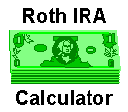| Brought to you by Maxwell Shmerler & Co., CPAs - For Tax Advise, Contact Us |
| Essentially, the Roth IRA was created for
middle-income taxpayers who are active participants in employee-sponsored retirement plans
and younger taxpayers in lower brackets preferring future tax-free withdrawals over
current tax savings. In a nutshell, contributions to a Roth IRA are not tax-deductible, but earnings grow tax deferred and can be withdrawn tax-free in retirement after age 59 1/2 if the account has been in place for at least five years. In addition, the Roth IRA permits certain early withdrawals without penalty, sets no maximum age limit for contributions and imposes no schedule for withdrawals.The one key limit the Roth IRA adds is a maximum income level; joint filers may contribute the lesser of $2,000 or 100% of their compensation (earned income) into a Roth IRA, as long as their combined annual income is below $150,000. Above that figure, the allowable contribution decreases and is phased-out completely at $160,000. For individual filers, the $2,000 maximum allowable contribution begins to phase-out at $95,000 and reaches zero at $110,000. Roth IRAs can be opened starting January, 1998. Taxpayers may contribute to a traditional IRA, a Roth IRA, or a combination of both, but an individual's maximum allowable total annual IRA contribution remains at $2,000 A Roth IRA also incorporates a few other options. Both traditional and Roth IRAs allow withdrawals after age 59 1/2, but unlike the traditional IRA, a Roth will permit contributions after age 70 1/2 and does not require withdrawals on any particular schedule. After five years, a Roth IRA allows tax-free withdrawals for a first-time purchase (up to $10,000), disability or certain emergencies without penalty, up to the amount deposited. Larger withdrawals i.e., including some or all of the interest earned in the account, will be subject to tax. The law permits people with annual AGI of less than $100,000 to convert their traditional IRA into a Roth IRA anytime during 1998. Those who choose to switch before January 1, 1999 will owe tax on the amount transferred, but the income can be spread out evenly over four years. The $100,000 AGI limit does not include the amount rolled over. For example, if a taxpayer with an AGI of $90,000 rolls over an IRA with a taxable balance of $60,000, the $15,000 added to AGI for tax purpose for the next four years is not included for purposes of meeting the $100,000 eligibility limit in the year of rollover. Many publications are infering that the tax due can be paid from IRA funds. Be aware that if you use IRA funds to pay your conversion tax, you may be liable for a 10% penalty on the non-converted amount. The converted funds should be kept in a separate account from regular Roth IRA contributions. A double 10% penalty is due on converted funds withdrawn before the five year requirement has been met. For the latest news from the IRS on the Roth IRA, Click Here. There are Estate Planning advantages to converting a regular IRA into a Roth IRA. Press HERE for details. For more information on a Roth IRA and whether its benefits are right for you and your family, contact the tax professionals at Maxwell Shmerler & Co. |

MAXWELL SHMERLER & CO., THE TAX PROFESSIONALS
Have Your 2003 Taxes Done Right. Contact Us Today

Please Make A Selection from the Choices Above
| FEATURE | TRADITIONAL IRA | ROTH IRA |
| Tax-deductible contributions? | Yes, income limits exist if individual or spouse is active participant in employee-sponsored plan. | No |
| Tax on earnings when withdrawn after age 59 1/2? | Yes | No, if taken more than five years after the initial contribution |
| Maximum annual adjusted gross income limit for contributions? | No | Yes. $100,000 for individuals, $160,000 for couples who file jointly |
| Contributions after age 70 1/2? | No | Yes |
| Penalty-free early withdrawals? | No | Yes, for a first-time home purchase, disability, or other pressing needs if made at least five years after first contribution |
| Mandatory withdrawals starting at age 70 1/2? | Yes | No |
ESTATE PLANNING ADVANTAGES TO ROTH CONVERSION
A taxpayer that does not plan to use the majority of retirement funds, but instead intends to leave them in his/her estate, may find it advantageous to convert their IRA into a Roth IRA.
If an IRA is part of an Estate, the beneficiary(s) are liable for the tax due on the IRA if and when they take a distribution. As part of the Estate, the value of the IRA may also be subject to Estate Tax, which is at a very high rate. By converting the IRA into a Roth, the taxes are paid before being subject to Estate Tax.
For example, an Estate, valued at $1,000,000, contains an IRA valued at $200,000. If, for example purposes, the Estate tax rate was 40%, than Estate tax is due is $400,000. The beneficiary takes distributions from the IRA and pays a total of $56,000 in tax when distributed. Total tax liability is $456,000. Conversely, the IRA is converted before death. The taxpayer pays the tax of $56,000 and the Estate is now worth $944,000. Estate tax due is now $376,600 for a total tax liability of $432,000. In this example, the tax savings is $24,000.
Estate Planning requires the advise of a seasoned professional. If you are looking for
Estate planning advise you can trust, contact the Tax Professionals at Maxwell Shmerler
& Co., CPAs. Just Click on the following image.
![]() back to top
back to top
Designed by Maxwell Shmerler & Co., CPAs - Your Full Service CPA Firm

Tax Information and Planning Tips - Click Here
